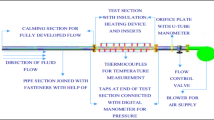Abstract
An experimental investigation has been conducted to clarify the effects of blockage ratio on forced convective heat transfer and pressure drag of an isothermal cam-shaped tube in cross-flow of air. The blockage ratio varies between 1.5 ≤ H/Deq ≤ 7 and Reynolds number based on equivalent diameter varies in range of 7.5 × 103 to 17.5 × 103. Results show that by increasing blockage ratio from 1.5 to 7, drag coefficient of the cam-shaped tube decreases about 55 % and increasing Reynolds number from 7.5 × 103 to 17.5 × 103 results in 40–48 % increment in Nusselt number. For better comparison, ratio of pressure drag over heat transfer of cam-shaped tube is compared with circular tube. In all ranges of Reynolds number and blockage ratios, thermal–hydraulic of cam-shaped tube is about 40–171 % greater than circular tube.














Similar content being viewed by others
Abbreviations
- BR :
-
Blockage ratio, H/Deq
- C D :
-
Drag coefficient
- C P :
-
Pressure coefficient
- d :
-
Small diameter (m)
- D :
-
Large diameter (m)
- D eq :
-
Equivalent diameter, P/π (m)
- H :
-
Distance between upper and lower plate (m)
- L :
-
Tube length (m)
- l :
-
Distance between centers (m)
- P :
-
Pressure (Pa), circumferential length (m)
- Re :
-
Reynolds number, U∞Deq/υ
- Nu :
-
Nusselt Number
- T :
-
Temperature (K)
- U :
-
Velocity (m/s)
- Ρ :
-
Density (kg m−3)
- υ:
-
Fluid kinematic viscosity (m2 s−1)
- θ :
-
Hole Angle (°)
- Cam:
-
Cam-shaped tube
- Eq :
-
Equivalent
- I :
-
Inlet
- O :
-
Outlet
- S :
-
Surface
- W :
-
Water
- Ave.:
-
Average
- ∞:
-
Free stream
References
Zukauskas A, Ziugzda J (1985) Heat transfer of a cylinder in crossflow. Hemisphere Publishing Corp., Washington DC
Zdravkovich M (1997) Flow around circular cylinders, vol. 1 fundamentals. Oxford University Press, Oxford
Zdravkovich M (2003) Flow around circular cylinders, vol. 2 applications. Oxford University Press, Oxford
Akilba’yev ZS, Isata’yev S, Krashtalev P, Masle’yeva N (1966) The effect of channel blockage on the local heat transfer coefficient of a uniformly heated cylinder. Problemy Teploenergetyki i Prikladnoi Teplofiziki 3:179–198
Ali M, Zeitoun O, Nuhait A (2011) Forced convection heat transfer over horizontal triangular cylinder in cross flow. Int J Therm Sci 50:106–114
Chakrabarty D, Brahma RK (2008) Effect of wall proximity in fluid flow and heat transfer from a rectangular prism placed inside a wind tunnel. Int J Heat Mass Transf 51:736–746
Singha S, Sinhamahapatra K (2010) Flow past a circular cylinder between parallel walls at low Reynolds numbers. Ocean Eng 37:757–769
Mohammed HA, Salman YK (2007) Free convective heat transfer from a constant heat flux vertical circular tube with different entrance restrictions length. Energy Convers Manag 48:2233–2243
Patil PP, Tiwari S (2008) Effect of blockage ratio on wake transition for flow past square cylinder. Fluid Dyn Res 40:753–778
Bharti RP, Chhabra R, Eswaran V (2007) A numerical study of the steady forced convection heat transfer from an unconfined circular cylinder. Heat Mass Transf 43:639–648
Turki S, Abbassi H, Nasrallah SB (2003) Effect of the blockage ratio on the flow in a channel with a built-in square cylinder. Comput Mech 33:22–29
Nouri-Borujerdi A, Lavasani A (2007) Experimental study of forced convection heat transfer from a cam shaped tube in cross flows. Int J Heat Mass Transf 50:2605–2611
Nouri-Borujerdi A, Lavasani AM (2008) Pressure loss and heat transfer characterization of a cam-shaped cylinder at different orientations. J Heat Transf 130:124503. doi:10.1115/1.2969259
Lavasani AMA, Bayat H, Maarefdoost T (2014) Experimental study of convective heat transfer from in-line cam shaped tube bank in crossflow. Appl Therm Eng 65:85–93
Bayat H, Mirabdolah Lavasani A, Maarefdoost T (2014) Experimental study of thermal-hydraulic performance of cam-shaped tube bundle with staggered arrangement. Energy Convers Manag 85:470–476
Quarmby A, Al-Fakhri A (1980) Effect of finite length on forced convection heat transfer from cylinders. Int J Heat Mass Transf 23:463–469
Webb R (1981) Performance evaluation criteria for use of enhanced heat transfer surfaces in heat exchanger design. Int J Heat Mass Transf 24:715–726
Yan W-M, Sheen P-J (2000) Heat transfer and friction characteristics of fin-and-tube heat exchangers. Int J Heat Mass Transf 43:1651–1659
Author information
Authors and Affiliations
Corresponding author
Rights and permissions
About this article
Cite this article
Lavasani, A.M., Maarefdoost, T. & Bayat, H. Effect of blockage ratio on pressure drag and heat transfer of a cam-shaped tube. Heat Mass Transfer 52, 1935–1942 (2016). https://doi.org/10.1007/s00231-015-1711-3
Received:
Accepted:
Published:
Issue Date:
DOI: https://doi.org/10.1007/s00231-015-1711-3




